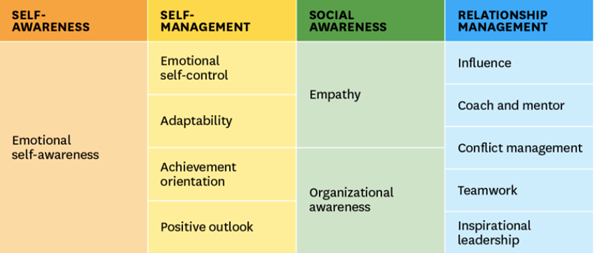Empathy: A Rare and Powerful Tool at Home and Work
[aikit_audio_player]
Empathy is a rare and powerful tool, both at home and in the workplace, that can be developed and mastered.
This article is for those who find “human-to-human” interaction challenging, fear returning to work, struggle with “social anxiety,” or simply want to succeed by ensuring their entire team is on their side.
The word “empathy” has its roots in Ancient Greek—Em (in) pathos (experience). In today’s context, it refers to the ability to recognize and understand another person’s situation or feelings, as well as the ability to share emotions. Empathy plays a significant role in emotional intelligence, as illustrated in the chart below.

Why is it so important to be empathetic in both your everyday life and at work? Because we spend so much time at work—often more than we do with our significant others. Building good relationships with colleagues and fostering an emotionally mature environment (free from “Game of Thrones” scenarios, backstabbing, or office politics) allows us to grow emotionally, makes us look forward to coming to work, and ultimately enhances our productivity, energy levels, and creativity.
[Here’s an interesting paper on the topic: Prof. Dr. A. G. Awan, M. Tafique Tahir, “Impact of Working Environment on Employee’s Productivity: A Case Study of Banks and Insurance Companies in Pakistan,” European Journal of Business and Management, Vol. 7, No. 1, 2015.]
Work-Life Balance
According to OECD data on labour hours per employee per year, our working hours have slightly decreased since the early ’80s but still hover around 38-40 hours a week. The pandemic, however, forced us into a “meet your family crash course,” with a comprehensive curriculum on how to spend and enjoy time with relatives. It also led to the largest global experiment on remote work environments.
As you read this, many companies are considering a hybrid work routine (part remote work, part in-office), with some already implementing it. However, it’s unlikely that our work hours will change drastically anytime soon—not always because companies are soul-sucking monsters, but because it’s often just not feasible.
Multinational, forward-thinking companies are usually at the forefront of such trends. They have the structures to quickly adjust their work environments, from modular interior designs to IT infrastructure, and HR teams capable of delivering polished instructions, procedures, and a “knowledge center” on how to work from home.
However, businesses like hospitality, beauty, and retail face more challenges. If the service or goods require physical labor, product presentation, or other face-to-face interactions, they primarily operate “on-site.” Additional difficulties arise from the challenge of finding qualified team members to handle a reduced workflow. The most challenging situation is in businesses like beauty salons, small retailers, and other B2C service providers, which often struggle with high employee turnover. Sometimes, this is their own doing, but often, they serve as a “stepping stone” in an employee’s career path.
Regardless of the type of business your employer represents, empathy will be an essential tool in your arsenal. The lockdown caused a rupture in team dynamics, and they will need to find a new rhythm. Many people will experience social anxiety after the “two weeks to flatten the curve” stretched into 14 months, and there will be many new colleagues due to company restructuring and rationalization.
[Read here about the impact of one extra day off on productivity.]
How to Cultivate Empathy in Your Thinking
To start, examine your thinking patterns. We tend to trust our brain’s algorithms unconditionally, often unaware that we can influence or even reprogram them.
- Assumptions: The first step toward greater empathy is eliminating assumptions. We often assume we know someone’s plans or agenda—stop! If you want to understand someone’s intentions, ask. Stop speculating and communicate. Effective communication is key to productive work; learn to listen to what is being said rather than interpreting it based on your assumptions.
- Intentions: The second step is recognizing when you expect someone’s intentions to be malicious—and this will happen. You pass this “second step” when you consciously let go of the idea of malicious intent and, through communication, simply listen.
- Listen: Active listening is an art and not an easy one. I believe it’s harder than anything else, but as I always say—do it or die trying. Listen to people’s stories, and if you’re not ready or interested in interaction, don’t pretend. Fake listening is against your integrity because it’s a form of deceit, and believe me, it’s noticeable—like acting in a scene without reading the script.
- Be Self-Aware, Not Self-Obsessed: Many people mistake talking a lot about themselves for self-awareness. It’s like believing a gym membership alone will give you a great body. True self-awareness involves analyzing your thoughts and questioning why you think the way you do. What influences the paths your brain takes? Challenge these habitual patterns.
- Observe: If “human-to-human” interaction doesn’t come naturally to you, that’s okay. Not everyone has the same set of skills. However, you can improve by observing people who are naturally jovial and charismatic. We learn mainly through observation, but it must be intentional and focused.
- Open Up: Don’t be afraid to share your emotions—there’s immense relief in expressing your hopes, fears, and expectations. Just be sure to share positive emotions too! Being open about your position in certain situations, especially conflicts, prevents anger and unspoken complaints from piling up and potentially “bursting” in a moment of weakness, which could cost you a relationship, friendship, or job.
Know the Difference
There is a significant difference between cognitive empathy and emotional empathy, and understanding this difference is crucial for responding appropriately.
- Emotional Empathy is the ability to share emotions, literally experiencing someone’s emotional state and responding with your own feelings. For sensitive individuals, emotional empathy can be intense, making it important to manage it.
- Cognitive Empathy involves understanding another’s emotions but not necessarily responding on an emotional level. This form of empathy is essential for managers and colleagues working in emotionally charged environments (like nursing homes, sports teams, hospitals), as constant emotional distress can take a toll on mental health.
Take Action
Lastly, don’t become numb—there’s one more type of empathy to consider: compassionate empathy. This type requires emotional maturity and involves not only understanding another’s feelings but also actively working to alleviate them—whether through advice, engagement, or simply a friendly hug. Compassionate empathy is the Holy Grail of emotional intelligence, and while it may be hard to attain, it’s worth every effort.
